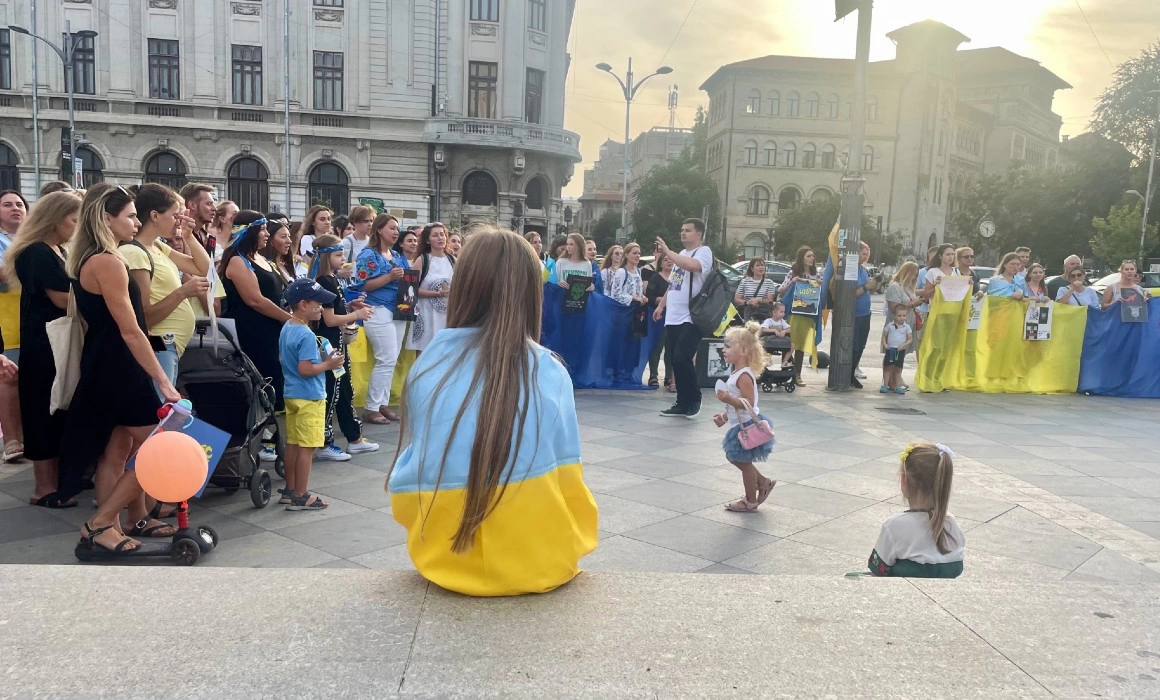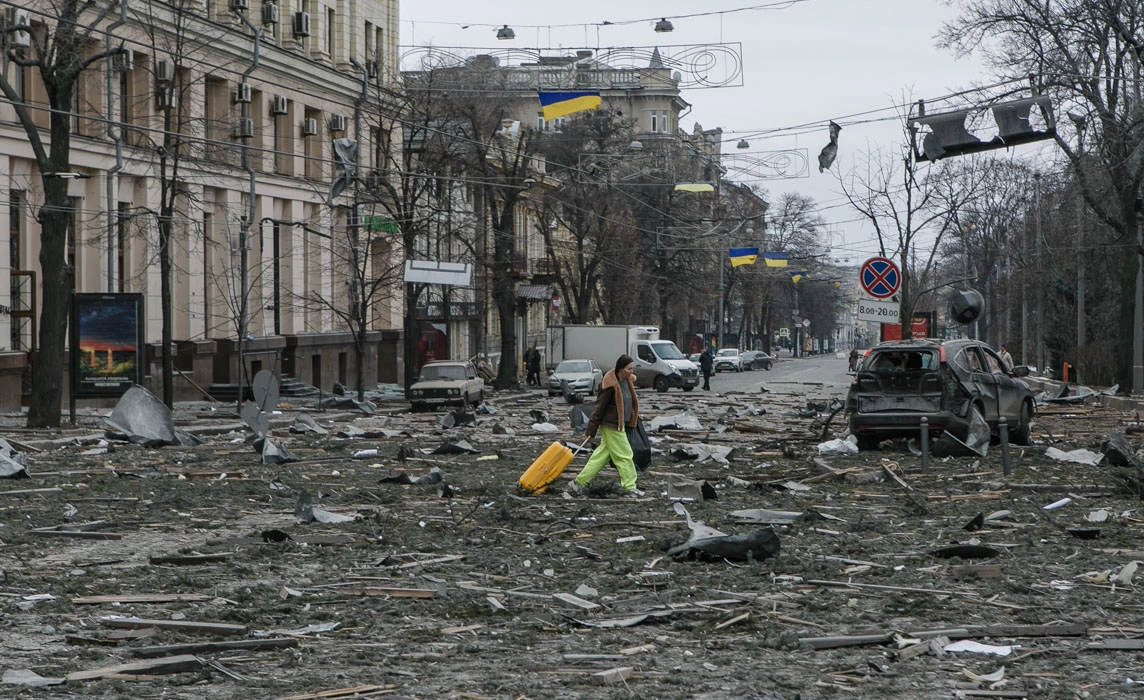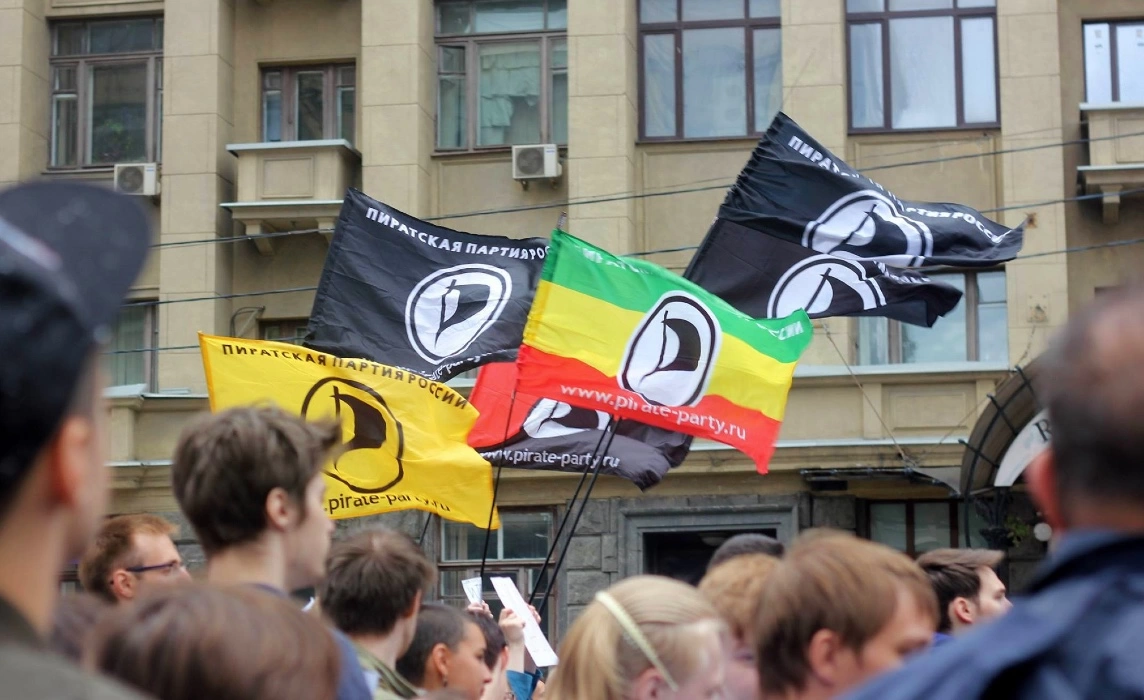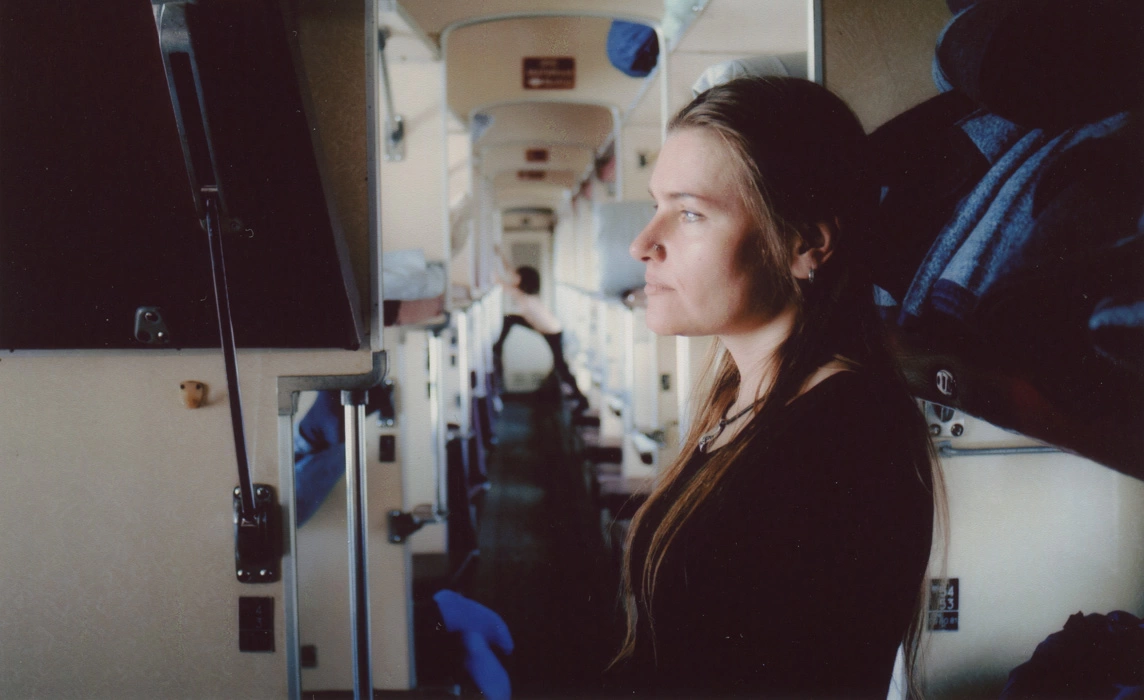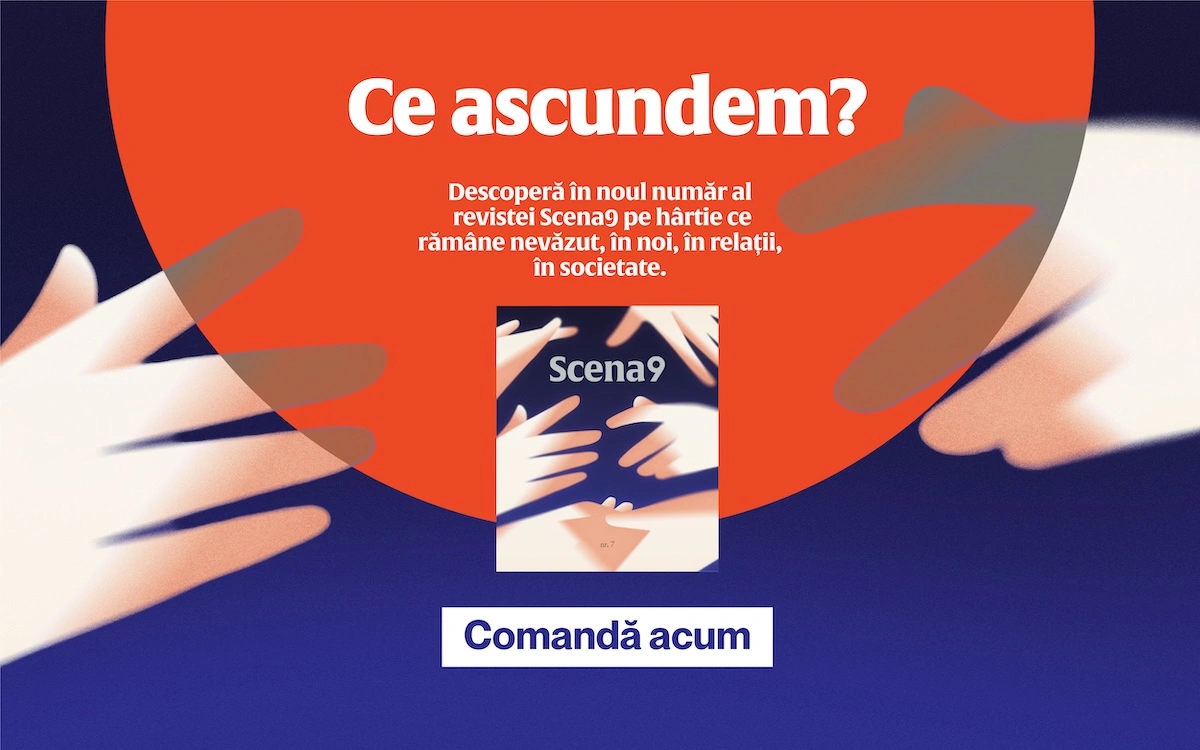A Romanian journalist and a Ukrainian anthropologist compare and contrast notes on two different (yet at times strikingly similar) Ukraine Independence Day events in Romania's capital.
It’s December 1 when I begin to write this text. It’s Romania’s national day, which it celebrates much like every other year, with a grand military parade in downtown Bucharest. The usual cold, gray weather, as well as the ongoing war in neighboring Ukraine make this year’s parade strike a particularly out-of-tune note. People are dying across our northern border by tank and by gun, while we parade our own tanks and guns before children.
As a geriatric millennial, I grew up in the shambles of Romania’s socialist regime - in the 90s, my early education was rife with patriotic poems and songs, which we recited during the requisite national day pageant, in compulsory traditional garb. Hark back to Treceți batalioane române Carpații, where we as 7-year-olds were basically cheering on for folks to go die in a war; or any of the plethora of verses that extolled the virtues of a country that largely existed on paper. Its bountiful land, its blue waters and skies, its gleefully hardworking countrymen. Like most people in my bubble (urban, middle-middle class, university educated), this nationalist upbringing left me abhorring anything that smacks of ‘patriotism’.
The inverted commas above, wrapped around the sentiment of loving one’s country, are there to suggest that this year made me question my aversion. To be clear: I am still highly wary of anything that even remotely resembles nationalist sentiment and grandiose statements of affection for having been randomly born anywhere have me rolling my eyes.
And still. I can’t escape the feeling that this year I witnessed a genuine brand of this sentiment in action.
On December 1, while my bubble was (at times cynically) reflecting on the state of our country, the facebook support groups for war refugees were brimming with well wishes from Ukrainians. Visuals of two children, or hands, or beautiful young women (always with one in red-yellow-and-blue and the other in blue and yellow) abounded. Ukrainians were wishing Romania many good things, but, most of all, they were praying for it to be blessed with “clear, peaceful skies.” This phrase in particular stuck. Not only does it appeal to a higher, sky-based entity, but it echoes their pleas in the early weeks of the war: Europe, close the sky over Ukraine. Stop the Russian war machine, which lives among the very same clouds as that merciful entity.
This text is not about Romania or its national day. (But it is about patriotism, and nationalism, and cultural identity.) It’s about Ukraine’s Independence Day, August 24, the de facto birthdate of the modern-day state, and the way it was celebrated in Bucharest. This year, I chanced upon one such celebration, while Ukrainian anthropologist Volodymyr Artiukh engaged in the observatory participation of another.
These were not the only such events in Romania this year: there was an official “solemn meeting” at the Ukrainian embassy in Bucharest and news channels reported events in several major Romanian cities, as well as in the Moldovan capital of Chișinău. In Kyiv, the regular military parade was banned under martial law and, as expected, Russia targeted and killed civilians in Ukraine, on the day that also marked precisely six months since the beginning of the full-scale war. Solidarity marches and gatherings took place in many major European cities, from Istanbul to Dublin.
In the first part of the text, I recount the August 24 celebration of Ukraine’s Independence Day organized by Zi de Bine, a Romanian charity that runs a day center for Ukrainian refugees; I also talk to the Ukrainian choreographer who came up with the idea of the celebration and co-organized it. I provide some context for cultural symbols that animated the event and reflect on my own perceptions of Ukrainian cultural identity, as framed by the current leg of the Russian invasion.
While I've editorialized too much in the above, Volodymyr delivers a sobering second part of this text. It's dedicated to his observations of the march co-organized by Asociația “1 Decembrie 1989” and Ukrainian teacher Daria Kustanovych, a war refugee from Kharkiv. He writes about performing transgression abroad, in a space that's rife with ideology, but at a time when the unity behind the frontlines "is yet to be filled with words and order." (Ioana Pelehatăi)
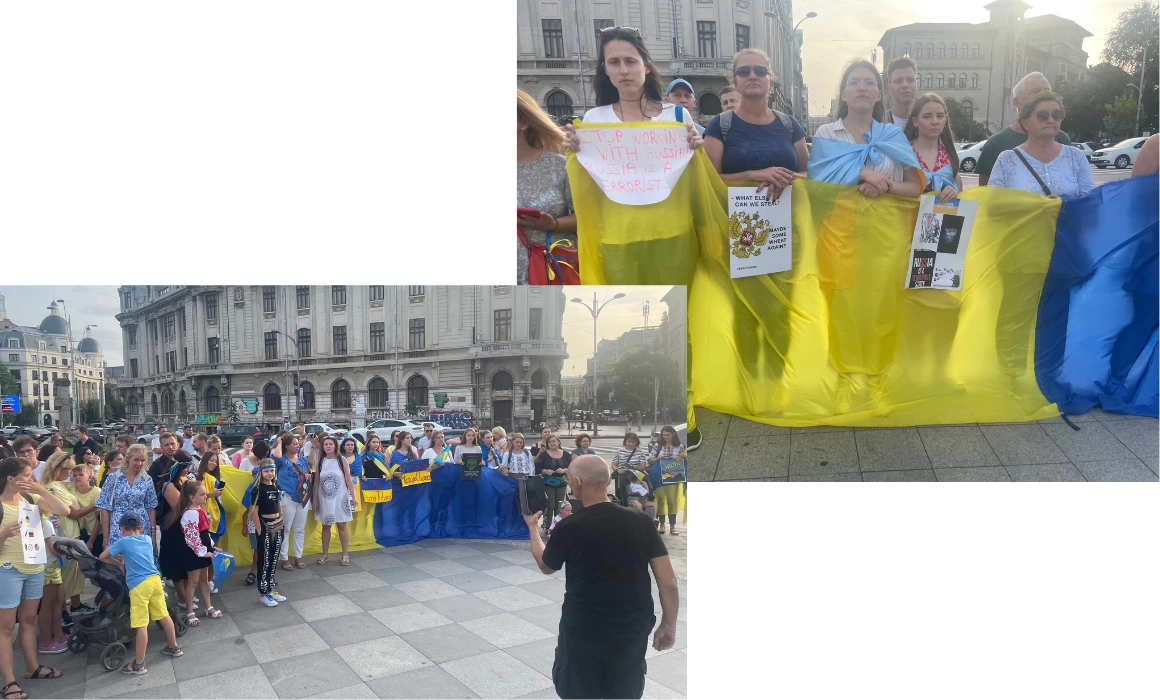
The pageant
by Ioana Pelehatăi
August 24, day 182 of the Russian invasion, comes in that brief part of the year when the light is merciful on Bucharest. It’s glowing golden on the iconic statues of the three men that stand at the core of the city center: the king, the revolutionary, and the educator. Behind the square, the onion dome steeples of what is still popularly referred to as the Russian Church of Bucharest jut out.
There’s about a hundred or so people here and I hear no Romanian whatsoever being spoken, with the exception of a TV reporter interviewing one of the organizers. Children are playing in a space delimited by riot fences that have been tamed by the addition of children’s drawings, paper flowers, and posters expressing slogans of Romania’s solidarity. Front and center, there’s a donation box for the Ukrainian Armed Forces. All around, there’s a significant number of Romanian riot police officers, in their black military uniforms. What was announced on Facebook as a flashmob, but will soon turn out to be a full-fledged show, has yet to begin.
August 24, 1991
The date when Ukraine celebrates its official birthday has seen many changes in the past century or so. In Soviet times, the Day of Independence was celebrated by the Ukrainian diaspora on January 22, marking the 1918 Declaration of Ukraine’s independence. Had the Ukrainian People’s Republic (1917-1920) survived, it would’ve been older than current-day Romania. In 1990, Ukraine declared state sovereignty. On August 24, 1991, it declared its independence, which was sanctioned by a referendum on December 1 that year.
To keep the many kids at the scene busy, the speakers are blaring Ой у лузі червона калина (Oh, the Red Viburnum in the Meadow). From the beginning of the war to this day, it remains perhaps the most easily recognizable Ukrainian song. The children hop about and sing along, and I find it difficult not to hum along and whisper the lyrics to myself.
Ой у лузі червона калина
This song, first composed in 1875, was made famous in contemporary times by Andriy Khlyvnyuk, lead of the band BoomBox. At the start of the war, Khlyvnyuk left his band’s tour of the US, and enrolled in the army. On February 27, he posted an instagram video of himself singing this song in Kyiv’s iconic (and deserted) Sophia Square. His rendition was then remixed to great success by South African band The Kiffness and included on Pink Floyd’s April 2022 single Hey Hey Rise Up.
Historically, the song has been associated with the Ukrainian People’s Army, during the 1917-1921 War of Independence, as well as with Ukrainian nationalist, militant, paramilitary, and terrorist groups during WW2. It is currently banned in Russian-annexed Crimea and singing it has been punished with fines and jail time.
The song speaks of the red viburnum, a berry shrub that features extensively in Ukrainian folklore. Nowadays, only the first stanza of the song is widely circulated; its other verses praise the Sich riflemen, a Ukrainian division of the Austro-Hungarian army during WWI, who saw Russia as their main enemy.
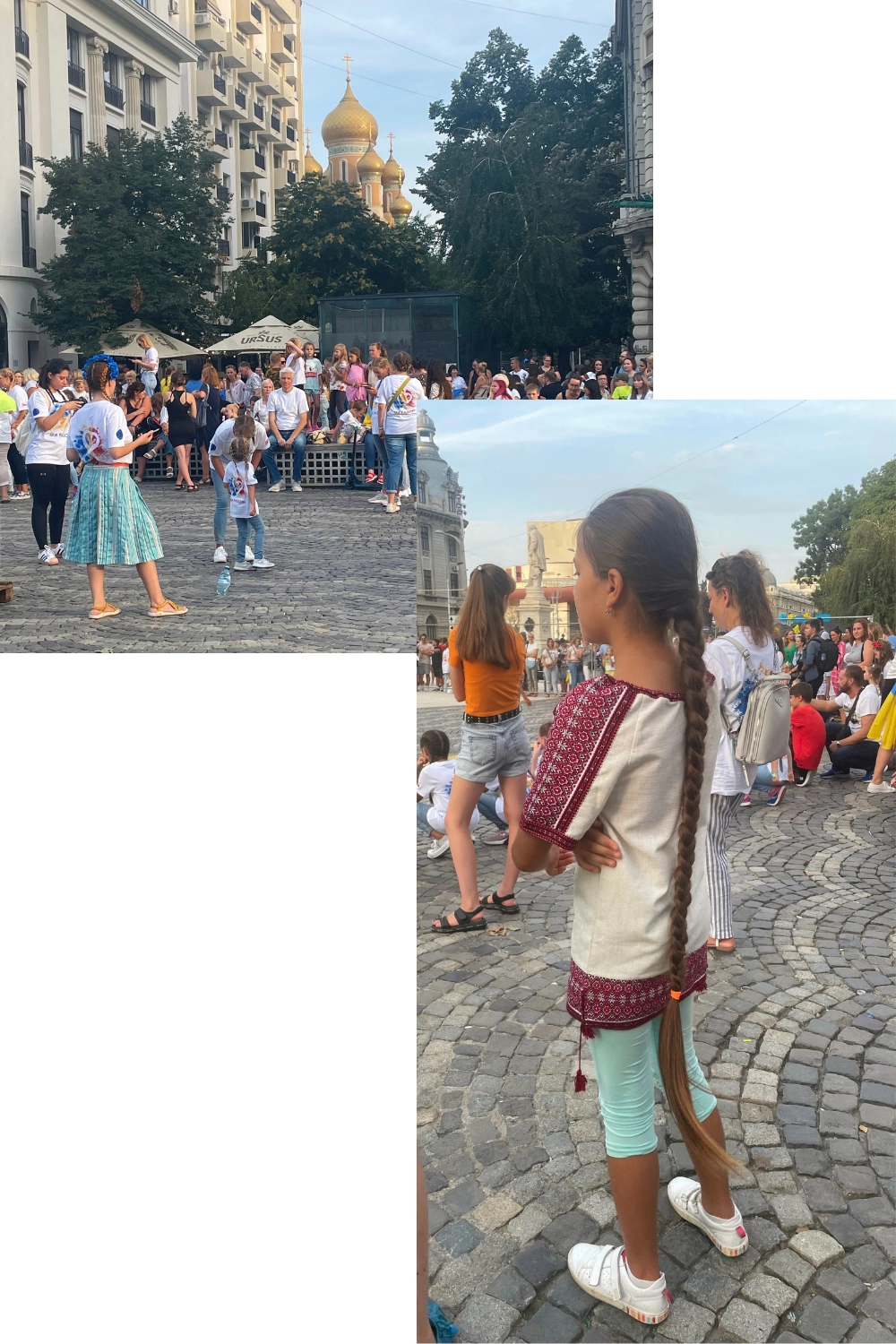
The celebration starts with a group of young women and children singing the Ukrainian National Anthem, Ще не вмерла України і слава, і воля. Like many who only searched for its meaning this year, I was struck by its first words, which are literally “Ukraine has yet to perish.” It resounds throughout the square and there’s an eerie silence around, as if this bustling, central space in Bucharest that never shuts up has suddenly frozen in time. I film the moment and the people around me, most of them women and children, who are mouthing the lyrics, hands to their hearts.
What follows is a regular pageant. There’s groups of kids who perform choreographed dances to the most popular recent Ukrainian hits: Go_A’s Eurovision-popular Solovey and Shum, as well as this year’s winner of the competition, Kalush Orchestra’s Stefania.
Ukraine at Eurovision
Go_A’s catchy electro-folk tunes give folkloric themes a tongue-in-cheek revamping for contemporary audiences. Solovey was the first entirely Ukrainian-language song to be picked for the Eurovision Song Contest in 2020 – a milestone in the language-related culture war between Ukraine and Russia. Because of the COVID pandemic, that year’s competition was postponed and Go_A had to re-enter with a new composition. The 2021 song, Shum, essentially picks up on vesnianka song-dances, traditionally performed to herald the arrival of spring, while also describing the sowing of hemp. The song placed fifth in the competition.
In 2022, Ukraine, represented by national contest runners-up Kalush Orchestra, went on to (predictably) win Eurovision. Kalush qualified to the finals after the winner, Alina Pash, withdrew over controversies regarding her travels to Crimea. Stefania is the third Eurovision win for Ukraine, as well the first-ever song with rap lyrics to win the contest. At the time of the finals in Turin, in April, one of the group’s members was serving in the Ukrainian army, in the Kyiv area.
A singer from Odessa performs a vintage ballad. Women, young and old, recite patriotic poems, the contents of which remain opaque to me because of the language barrier. I can, however, tease out the words for “my homeland,” “beauty,” “glory,” “love,” and, of course, Ukraine. Ukraine is in the paper poppies strewn along the fence panels, in the children’s drawings and words (Peace in the world, Ukraine we are with you), in their plaited braids, vyshyvanka blouses, flower crown wreaths, and in the more modern merchandise – like the St Javelin-style tote bag below.
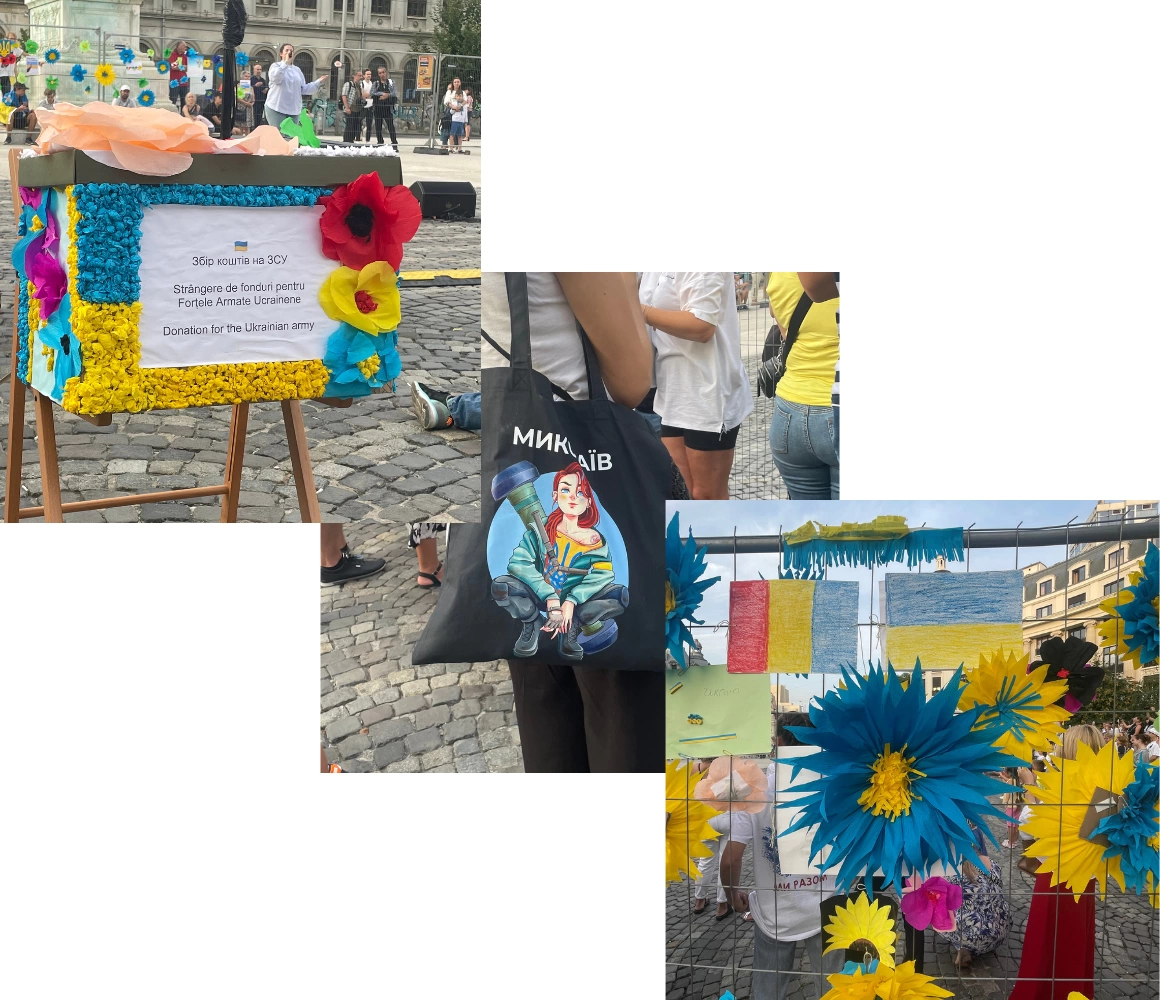
Everything ends with what was initially supposed to be the sole event of the celebration: the flashmob choreographed by Maria Syhopara.
Months later, on Romania’s own national day, when I meet Maria at the Zi de Bine day center, her first on record sentence is an admirative exclamation at the brooch I’m wearing - a blue heart with a yellow border and the Ukrainian trident on it. I tell her I got it at another event that celebrates Ukrainian culture: the food and craft fairs regularly oragnized by refugees at Manasia Hub. You can eat borscht and vareniki, as well as buy handcrafted kids’ toys – or socks that say “Russian warship go f*** yourself!”.
Maria (37) instantly wins you over with her expansive nature, but there’s also her piercing gaze that speaks of her level of determination. She and her entire family (complete with her parents, her son, her aunt, and the bulldog Johnny) arrived in Romania some three weeks after February 24. Her husband is in Ukraine, volunteering in support of the army. They chose Romania because Maria had previously worked here; they’re now living in a flat under the 50/20 program. Maria has nothing but kind words about Zi de Bine, its directors Melania Medeleanu and Luciana Zaharia, and Romania in general.
The choreographer came up with the idea of the flashmob because she had organized similar events for the day of her city, Mikolayiv, in the south of Ukraine. What started out as a simple idea for a single event turned into a whole show, with several dances, songs, and poetry recitals. In organizing, Maria received the help of her friends: Nadya, who sat with Maria’s baby while she was working, and Irina Orlova, who helped with the music.
I ask her why she did it. Why sing and dance at a time like this? She tells me that she knew about the protest held in the other half of University Square at the same time as their event, but wanted to do something different. “We protest every Sunday, this time I wanted to show something positive. (...) Of course, in our country now it's crazy. (...) We see how Russia kills people and children. We see that people now live without light, water, gas. But when people came to the square to see our show, I saw their eyes. They were really, really happy. And that's what I wanted to say. We wanted to show that our country is strong and we will win and we will go back.”
We end our conversation with Maria’s thoughts on how Romania and Ukraine are very similar – both countries have the Carpathians and the Black Sea, the Orthodox faith, and Christian traditions. Before the war, she says, people in neither country knew much about the other, but now they’ve seen the similarities. With one exception, she says. Ukraine is still not in the European Union. That’s something she hopes will change soon.
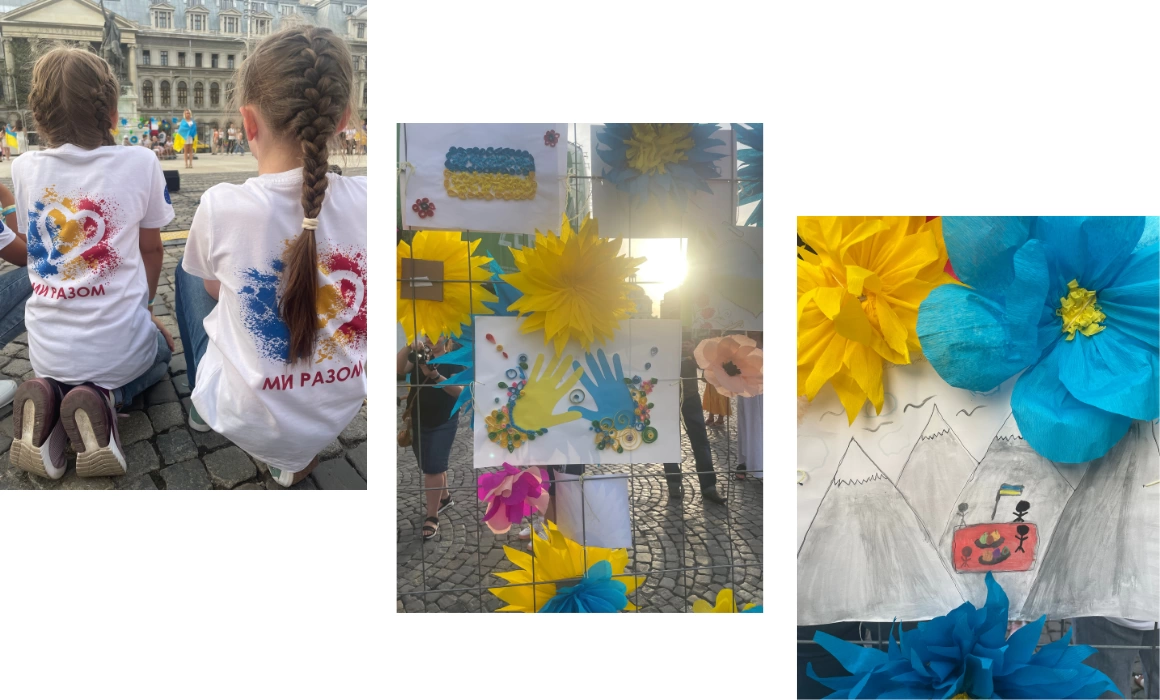
This desire to accede structures such as NATO and the EU has arguably been the driving force behind much of what Ukrainian civil society sees as positive change in the country, in the wake of the 2013-4 Maidan uprising. I wrote about it here, reporting from Kyiv on the eve of president Zelensky’s 2019 electoral win. It is not my place to comment on this wish, nor is it within the scope of this text. For now, I will, however, quote musician Marko Halanevych, of ethno-chaos group DakhaBrakha. Three years ago he told me: “We are the representatives of a post-colonial culture. We live under the impression we are a very small people. We don’t believe we can create something that belongs to Ukraine, something that the world will understand as Ukrainian culture. We grew up under the shadow of the great Russian culture and we feel as if we’re from the countryside.”
The culture packed in the war refugees’ luggage in 2022 is decidedly and recognizably Ukrainian. It is designed to smash that colonial yoke to bits. It couldn’t be any other way, at a time like this. A time when The Ukraine that writer Artem Chapeye described in the short story of the same name is being purposely defaced. That country, which he affectionately depicts, is of the small town, the marshrutka, the everyday – it eschews loud, boastful patriotism and writes it off as being “like a penis: regardless of its size, it’s not a good idea to wave it around in public.”
I look at self-described antiauthoritarian leftist Chapeye now: he has been enrolled and serving in the Ukrainian army from the early days of the war. “Psychologically, I think it was important to turn myself from a ‘victim’ civilian into an ‘agent’ resisting the oppression,” he explained in an interview for The New Yorker. A political analyst in my Facebook feed recently remarked that patriots are those who want to do something for the motherland, while nationalists are those who simply want us to talk more about their motherland. While not discounting that current-day Ukrainian patriotism can be a breeding ground for nationalism, I will place this actionable sentiment in a decolonial frame and, for the time being, embrace it.
The march
by Volodymyr Artiukh
I chose the demonstration at the University square on purpose, as I saw an ad on one of the Facebook groups for Ukrainian refugees in Romania. I was intrigued by the co-organizer of the event, the "21 Decembrie 1989" Association. As my Romanian wife explained to me, it was an old political group, tracing its roots from the students’ protests during the 1989 revolution, and now enjoying controversial fame for its conservative-nationalist agenda. The meeting between highly politicized Romanian organizers and Ukrainians who gather on the occasion of the Independence Day, at a time when Ukraine’s independence is in mortal danger, promised a glimpse into a political self-representation of Ukrainian migrants. There, the celebration of the Ukrainian Independence Day would confront the site of the most iconic Eastern European 1989 revolution. The destination of the march, the Russian embassy in Bucharest, promised an emotionally heightened culmination of the event.
On the way to the University Square I stopped by a cordoned off square full of children in ‘We are together’ t-shirts with blue-and-yellow hearts. This was preparation for the song and dance festival that Ioana described above. The decorations transported me to the days of my Ukrainian childhood with folk costumes and a mix of the tolerated pop and the intolerable folk in school’s ‘act halls’. There the decaying Soviet invented tradition and the nascent post-Soviet naive pop merged, and here this merger reached a new cosmopolitan level with the Pink Floyd arrangement.
Paradoxically, the war, the most particularizing event possible, catapulted a typical Eastern European national aesthetic onto the level of the universal. In the dance festival, as I expected, this aesthetic particular-universal would be played out as a spectacle of normality, perpetuating the ordered national in the face of the physical destruction of the nation-state. Leaving behind the performance of the peaceful unity, I was heading to an assembly that aimed to bring the war with itself, in the form of politics — its starting point by other means.
The crowd at the University square was gathering slowly. Ukrainians and Romanians on the top platform of the square, older ones sitting on the benches, kids playing, mothers walking with baby strollers, looked at the activists with banners and a huge yellow-blue cloth, who formed a semi-circle down on the pavement. There was a sense of an amphitheater, with a clear but penetrable division between the audience and the scene. The scene itself had a recognisable structure: the protagonist - a young Ukrainian pedagogue Daria, with a posture of either a fighter or a school teacher - addressed the ‘chorus’ of three dozen people, mostly women with children. Romanian organizers were largely silent: they helped with the equipment and filmed the event.
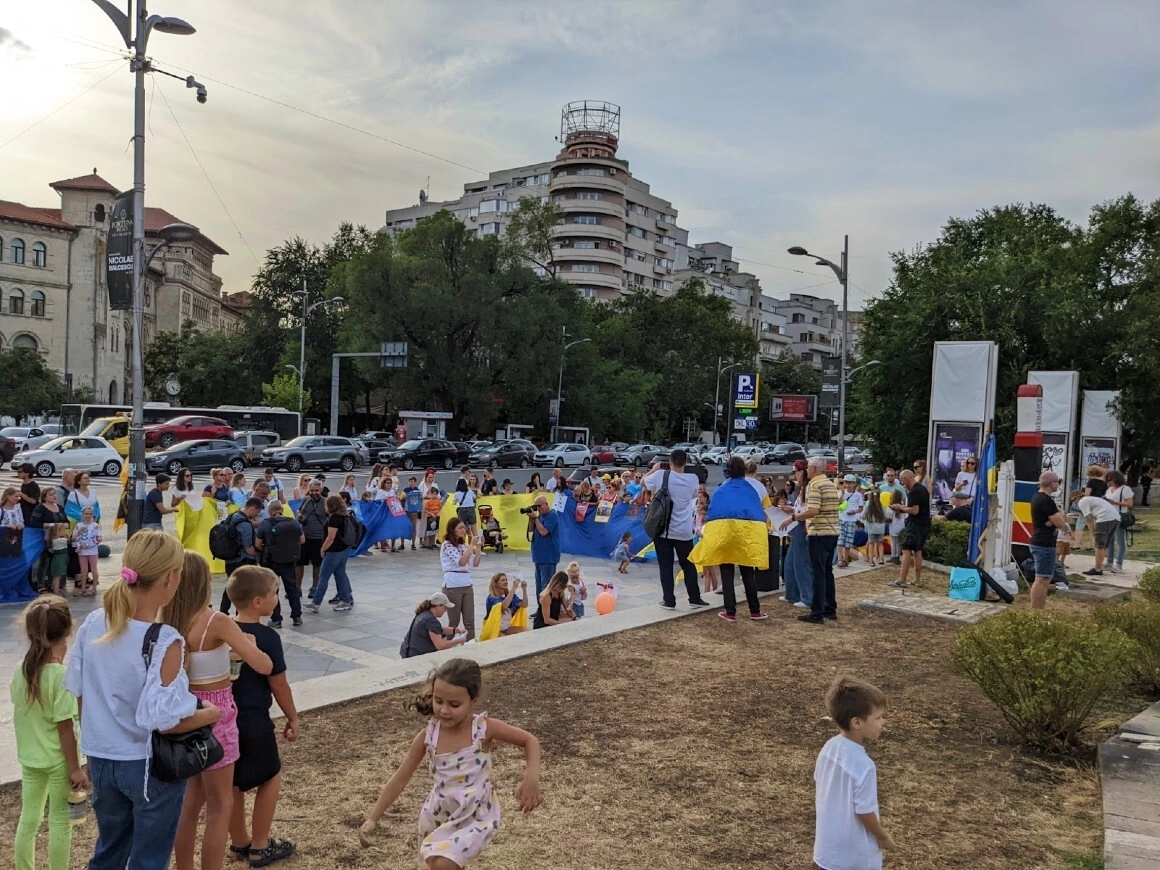
Daria was chanting short, brisk, provocative slogans with a curious tone that oscillated between that of a military leader commanding a unit and that of a primary school teacher trying to make kids learn new words. First she introduced the main topic of today’s celebration: ‘Glory to the armed forces of Ukraine’ and ‘Freedom to the defenders of Azovstal’. The ‘chorus’ responded in a disciplined manner, switching between Ukrainian and English, raising and lowering their voices to follow the protagonist. The discipline was evident, which made me assume that the people with the banners were regular attendees of the Saturday demonstrations held by Daria.
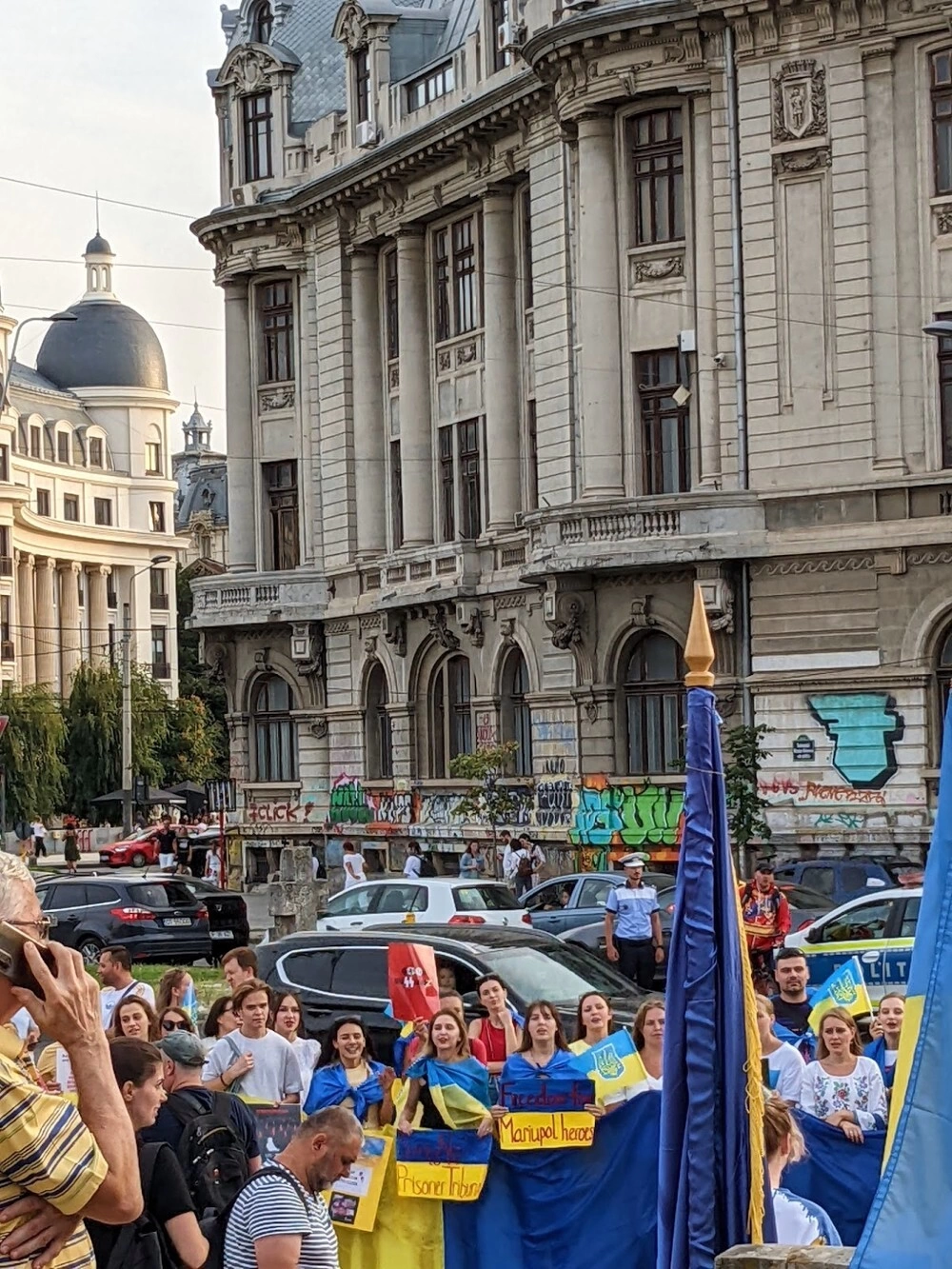
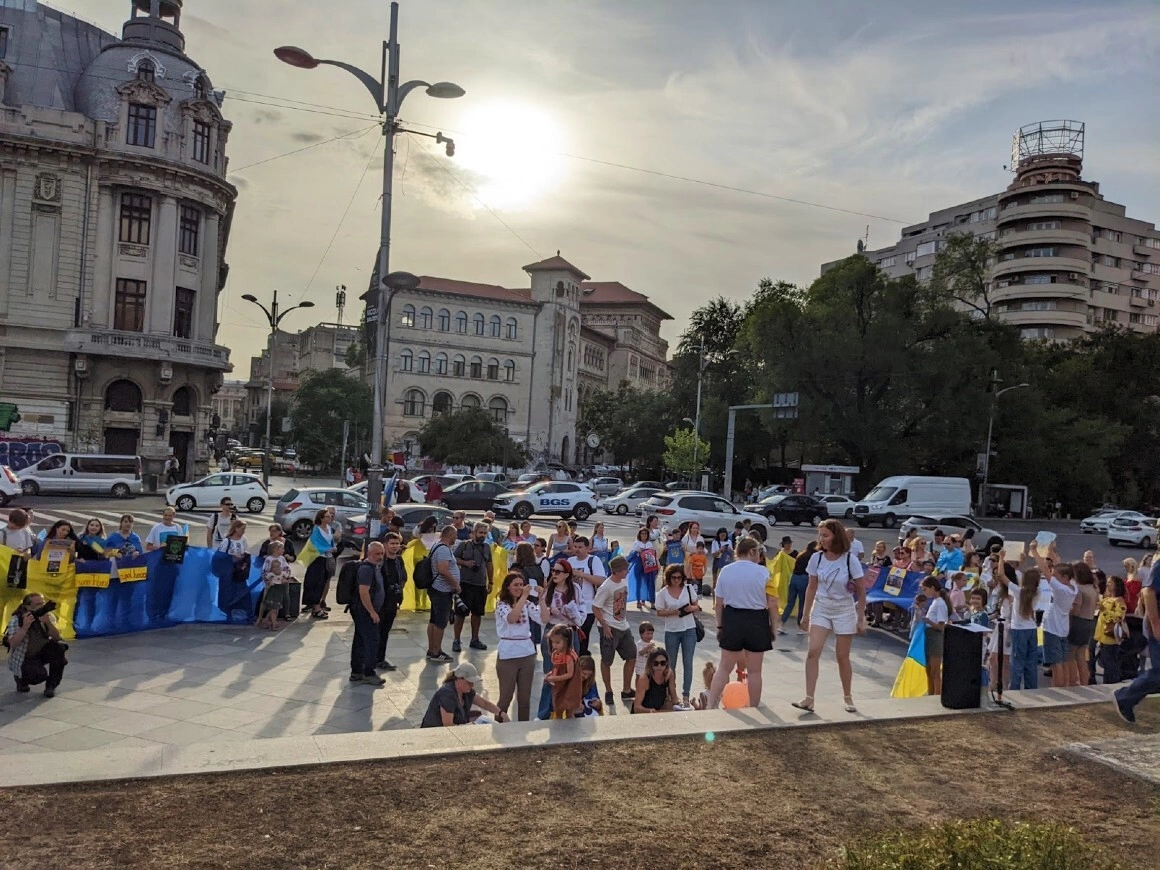
I recognized some of the slogans that entered the repertoire of pre-war mass perturbations in Ukraine, while others were new, and some were evidently improvised. I wonder how many ‘lay’ participants had their first street demonstration experience here at the University Square, or whether they learned most of the slogans from the media. The engagement of the surrounding mass dropped from the middle to the outskirts of the gathering. There I noticed Ioana, who only dropped by for the beginning of this demo to later return to the dancing show. We exchanged greetings of two people at work, our paths parted to bring you a fuller picture of Ukraine’s Independence Day in Bucharest.
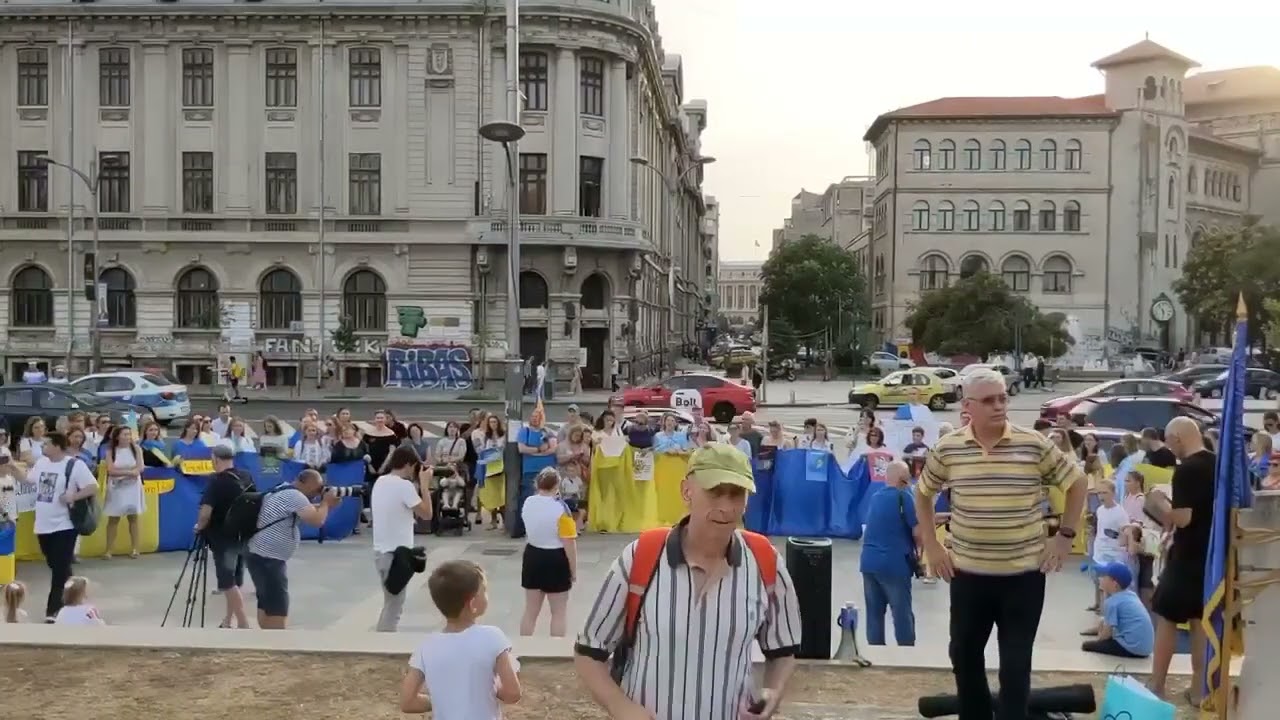
The atmosphere at the event reminded me of the first Maidan, where I participated as a student in 2004, and the second Maidan of 2013/14, which I already missed, being a migrant, but visited as a guest in my country of birth. That was a very familiar tradition of loud, intense chanting, and some of the slogans chanted on this Independence Day stem from 20 years ago. Such was the famous ‘hanba’ (‘shame’) that every Ukrainian politician was destined to hear at some point in his or her career. Others were the heritage of the second Maidan: ‘Glory to Ukraine,’ ‘Death to the enemies,’ ‘Ukraine above all,’ ‘Putin is a dickhead’ (Путін - хуйло, see below) Still others originated in the first days of war and spread through all Ukrainian TV channels and online media: ‘Russian warship, go fuck yourself,’ ‘Glory to Ukraine - glory to the nation - perishment (pizda) to the Russian federation.’
Путін - хуйло
The history of this expression reflects key features of the post-Maidan Ukraine. Its full version, 'Putin khuylo, la la la la la la la la,' was first performed by Kharkiv football fans in March 2014, shortly after Putin's annexation of Crimea. The chant was an adaptation of an older hooligan slogan directed against an oligarch director of the rival football club, Viktor Surkis.
The chant was quickly picked up by the fans of other football clubs as well as by the broader activist public that have participated in Maidan protests. This fact demonstrates the unprecedented prestige enjoyed by football hooligans and other far-right groups after Maidan, where they were at the forefront of the violent clashes with the police. Notably, Kharkiv football fans in engaged in fights with pro-Russian demonstrators and would constitute one of the pillars of the Azov movement.
The indecent chant became a rallying cry among the followers of Maidan and patriotic public in general in times of the war in Donbas. During a famous incident at the Russian embassy in June 2014, the then Ukraine's acting minister of foreign affairs Andriy Deshchytsia was forced to repeat the undiplomatic slogan after the angry crowd in an effort to defuse the situation and prevent storming of the embassy.
Deshchytsia left his post, but the Wikipedia article about this slogan rose to the top of the Ukrainian-language version of the free encyclopedia. This showed how much state politics was influenced by the pressure from the organized masses in post-Maidan Ukraine. Ukraine's new government, weakened by the annexation of Crimea and the pro-Russian uprising in Donbas, had to struggle finding a balance between the requirements of international politics, especially after the signing of the Minsk Accords, and the pressure of the nationalist forces within Ukraine.
Subsequently, 'Putin khuylo' would be used by numerous singers and artists in Ukraine and abroad, it would enter the political repertoire of anti-Russia activists and the Russian opposition. It should be remarked that 'khuylo' is one of the most extreme swearwords one can find in Ukrainian and Russian vocabularies. The obscene expression would also be represented in numerous abridged and euphemistic forms, such as ПТН ХЛО, Putin Hello, Khutin Pui, etc.
Both Maidans were experiences of effervescence, a unity born out of the very process of participation. For those who took part and even sometimes suffered under batons and bullets, the world and the history broke into two. Before and after, inside and outside. Events restricted in space to a square and in time to several months were experienced as something universal to which one had to keep fidelity. This fidelity was at times stronger than party belonging, ideological persuasion, citizenship. It came with a strong sense of ‘dignity’ - the keyword of both Maidans - that gave one a moral and political right to decide who was undignified.
This sense of authenticity and processuality was revived at this gathering before the march. At this event Ukrainians performed fidelity to something many of them didn’t take part in - or were even opposed to. That was probably something that a representative of the Romanian co-organizers, the "21 Decembrie 1989" movement, had in mind when he told Ioana that his NGO was the only one who had the legitimacy to organize something for Ukraine’s Independence Day. Like Ukrainian witnesses of Maidans, members of "21 Decembrie" were faithful to their participation in the violent days of 1989.
In a way, the experience of collective unity outside of time and space against one enemy - the experience of the Independence Day demo - is a metaphor and a metonymy of the state of Ukrainian society. Maidan-2013/14 partitioned Ukraine into those who experienced or have been persuaded to share fidelity to the protests on the Independence Square and the others, those who rejected this fidelity or remained indifferent. The 2022 war left no such choice. Even the most anti-Maidan, formerly pro-Russian citizens started hating Putin’s guts or joined the army outright. In this sense the war created an affective, albeit structureless unity behind the frontline. This unity is yet to be filled with words and order.
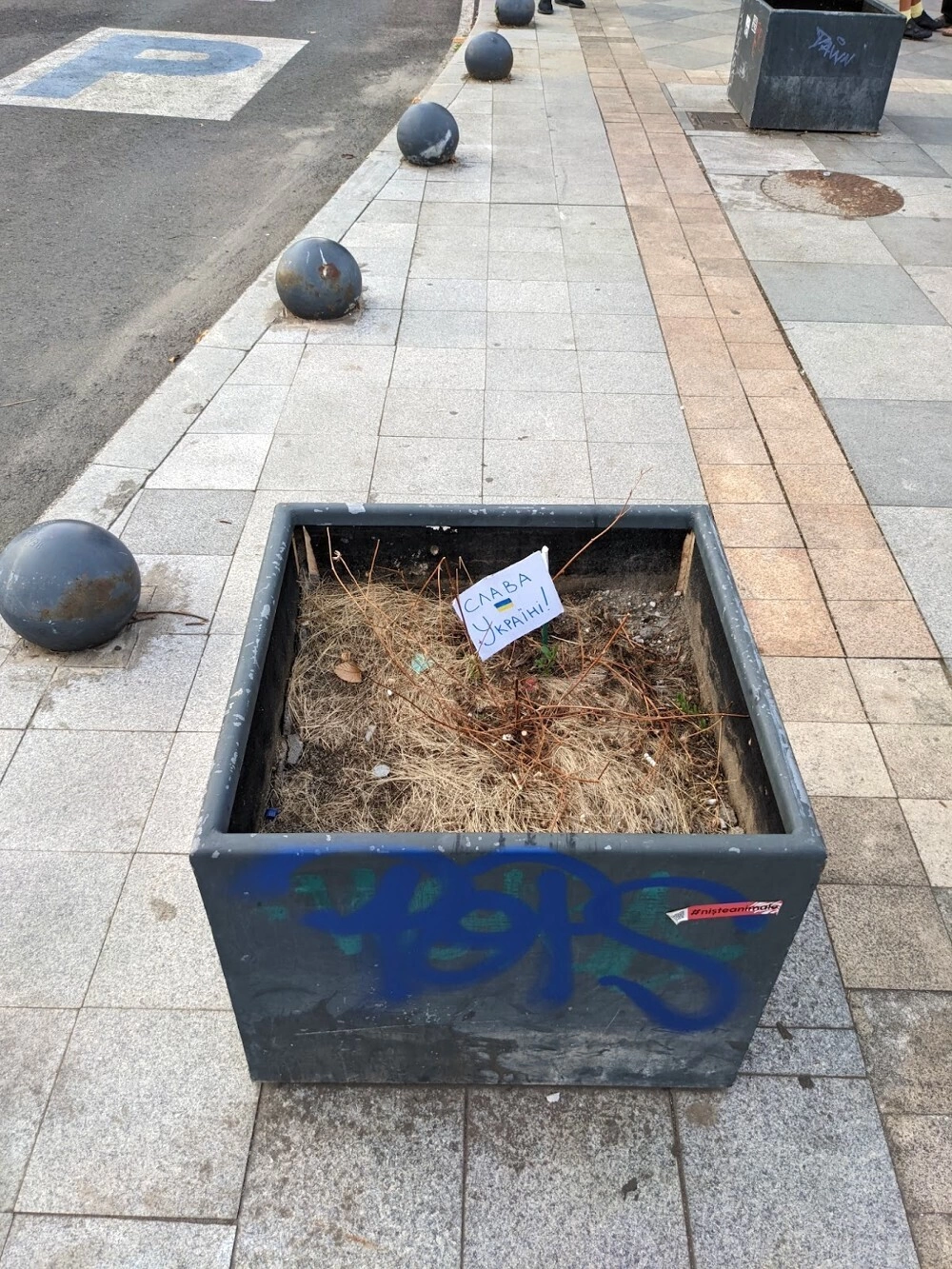
The affective unity in the war was performed by a round of interpolations by Daria: are there people from Kharkiv? Are there people from Kherson? Are there people from Mykolaiv? Irpin, Mariupol, Donetsk, Luhansk regions? (No). Bucha is Ukraine, Kherson is Ukraine, Mariupol is Ukraine, Donbas is Ukraine. But what is to be Ukraine now when politics is only done by other means? What is there to identify with, if your former life in Mykolaiv or Kherson did not predispose you to ideological fidelity? What remains is obscenity, a shared experience of transgression. Daria presented the paradox of a teacher that teaches indecency, the worst swear-words known in Ukrainian, to the children. The soul of the nation is less in its ideals, lofty words about unity, than in the licence of the shared obscenity. Young children repeated syllable after syllable - ‘Pu-tin khuy-lo’ (Putin is a dickhead), ‘piz-da ros-siy-ski fe-de-ra-tsi-i’ (the Russian Federation is fucked), ‘Russian warship… fuck yourself’.
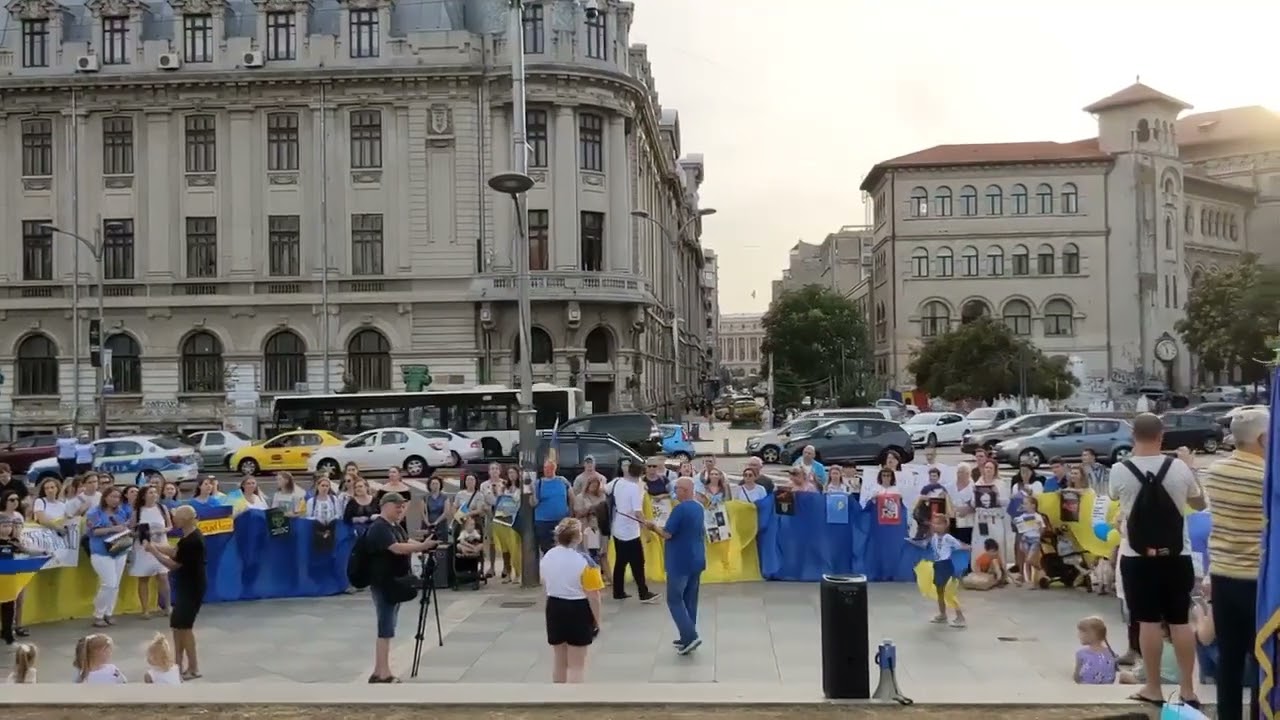
Politics is the starting point of the war, albeit by other means, if I am allowed to paraphrase the banality of a XIX century German general. Politics is about enemies, war is about heroes. The enemy was clear, and it was a terrorist state (‘It’s not Russia, it’s terrorussia!’) that should be isolated from the rest of the world (‘Full embargo on Russia!’). In one version of the interpretation of the Romanian history shared by the members of the "21 Decembrie 1989" association, Russia was also behind the first post-revolutionary leadership that clashed with the students on the University Square. At the destination of the demo, at the Russian embassy, the slogans chanted by Ukrainians in Romanian would accuse the Russian ambassador of working for KGB and symbolically equate Russians and Hungarians: afară, afară cu rușii din țară. Thus, a common Ukrainian-Romanian space of indecency was found.
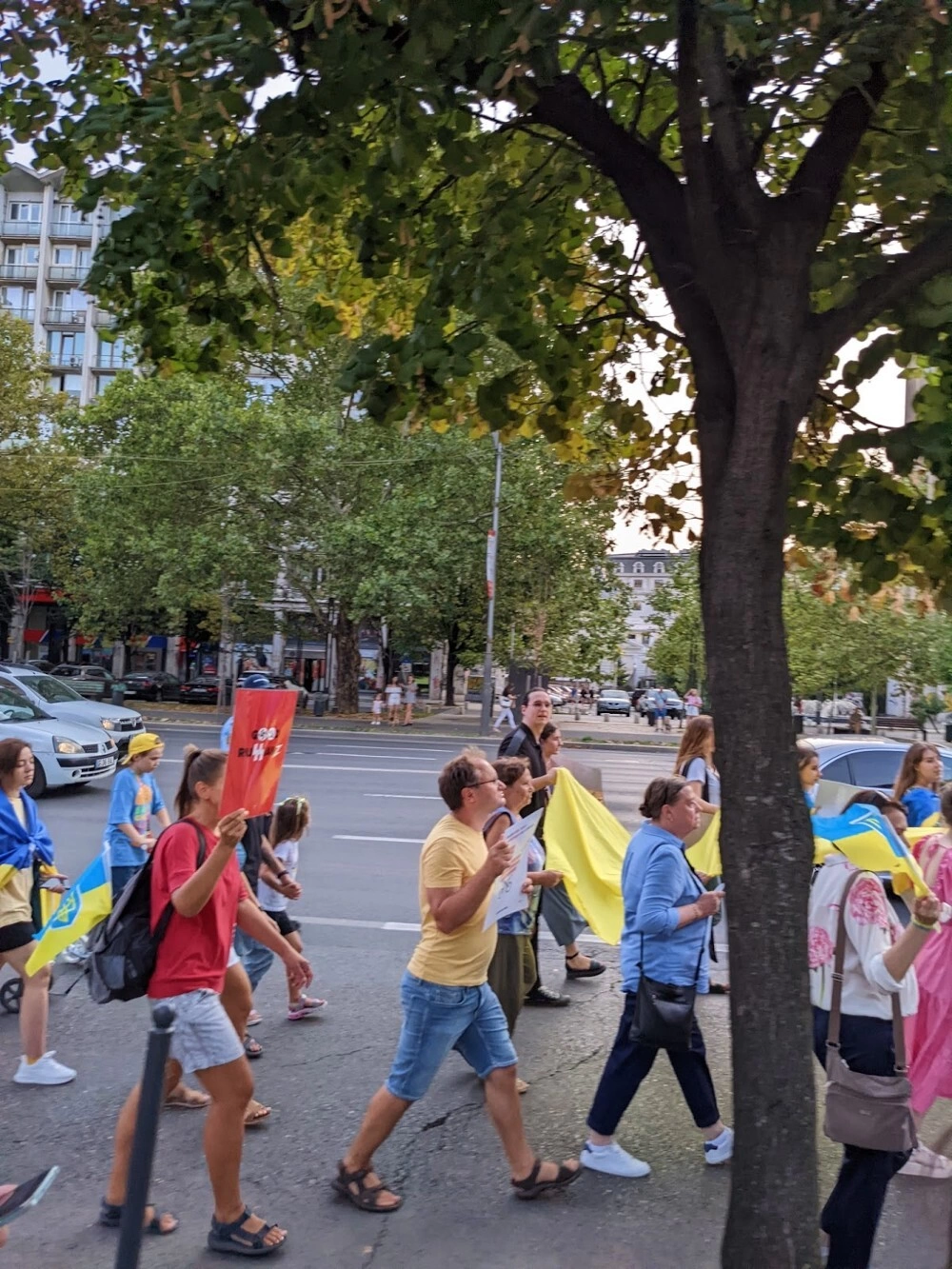
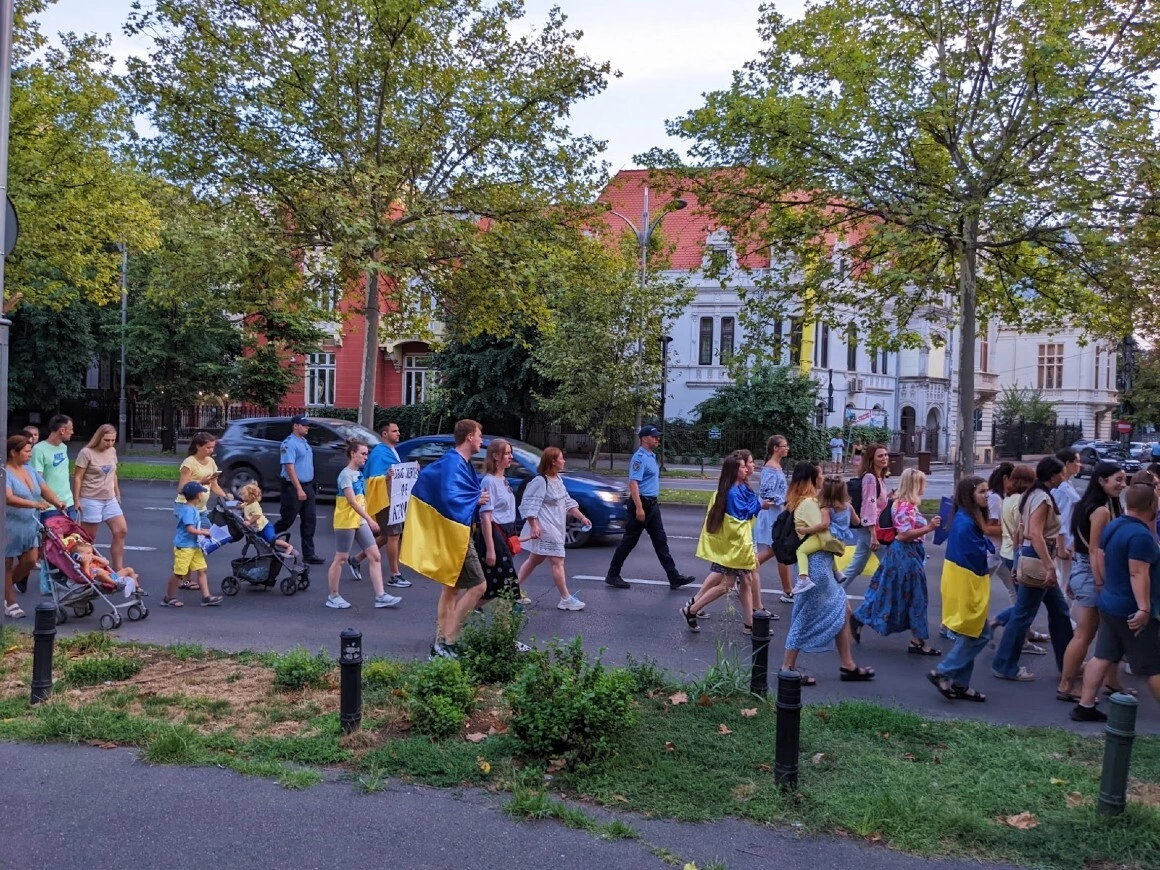
The heroes depicted on some of the banners were the defenders of Mariupol, or the Azovstal heroes. Participants of the march in a way shared the suffering of heroes. The way from the University square to the Russian embassy was long. Even I felt pain in my legs - it was hard to watch mothers with several children, some of whom were constantly asking to be held in their mothers’ arms. At the Russian embassy everyone was rewarded with a carnival of insults, indecency, and ritual cursing. I left after I heard a small child reciting slogans full of swear words.
Azovstal
Azovstal ('Azov steel') was a giant steelworks in Mariupol spreading several square kilometers over a network of underground tunnels and bunkers. It was built in 1933, contemporaneous and coextensive with the monsters of the Soviet industrialization: the Magnitogorsk Metallurgic Plant, DniproHES, the Kuznetsk Steel Plant, and others. Together with the Illich Metallurgical Complex, Azovstal transformed the port city of Mariupol into a multi-ethnic industrial metropolis rivaling Donetsk itself in size. After Ukraine gained independence, both plants were merged and sold to Ukraine's richest oligarch, Rinat Akhmetov.
During the war in Donbas, Mariupol avoided the fate of Donetsk and Luhansk, partially due to the influence of Akhmetov, who took the government’s side in the conflict, ans partially due to the mobilization of pro-Ukrainian paramilitaries. Specifically, the Azov Battalion, initially a paramilitary unit consisting of far-right activists and football hooligans from Kharkiv, later incorporated into the structure of the Ministry of Interior, helped clear Mariupol of pro-Russian fighters and defend the city throughout 2014. However, Mariupol was immediately besieged after Russia's full-scale invasion of Ukraine on 24 February 2022. After nearly two months of apocalyptic destruction wrought on the city by the invading army, over 2.000 Ukrainian forces and civilians found refuge in the Azov Steelworks complex.
Most of the civilians were evacuated in the first week of May through the mediation of the UN, while the fighters of the National Guard's Azov regiment and the 12th brigade, marines, border guards, the police, and Territorial Defense units surrendered in the last week of May. The surrender proved to be a short-lived symbolic prize for Putin. The fighters of the Azov regiment with far-right roots were the proverbial nazis that Russian army had allegedly come to punish. The show trial was supposed to take place sometime in August - participants in the demonstration described in this article make references to this trial. However, Turkey and Saudi Arabia mediated a prisoner swap according to which a group of war prisoners who were defending Azovstal had been exchanged for Russian soldiers held captive by Ukraine and for a Ukrainian politician Viktor Medvedchuk, a personal friend of Putin's.
The three-month long defense of Mariupol helped slow down Russia's lightning offensive in the south of Ukraine and tied up to 20 000 forces, thereby contributing to the debacle of Putin's blietzkrieg plan. Russians managed to capture the city at the cost of its virtually total destruction. The monument of Soviet modernity, Azovstal, will not be rebuilt. Thus, Russia's red-flag carrying tanks paradoxically erased the material foundation of Soviet legacy.
The last years of Mariupol are reflected in numerous artistic works worth watching. Mariupolis 2, a film by Mantas Kvedaravičius, a Lithuanian anthropologist and filmmaker tortured and assassinated by the Russian army, won numerous awards. In Sasha Protyah's Khait, one looks at the utopian postindustrial Mariupol and its Greek-inspired electronic music.
The Romanian language version of this article is here.
Material produced with the support of a grant from the project "Strengthening the resilience of Western democracies in response to the war in Ukraine and its consequences at the European and global level" carried out by the Center for Independent Journalism (CJI) and the Friedrich Naumann Foundation for Freedom Romania and Moldova.
